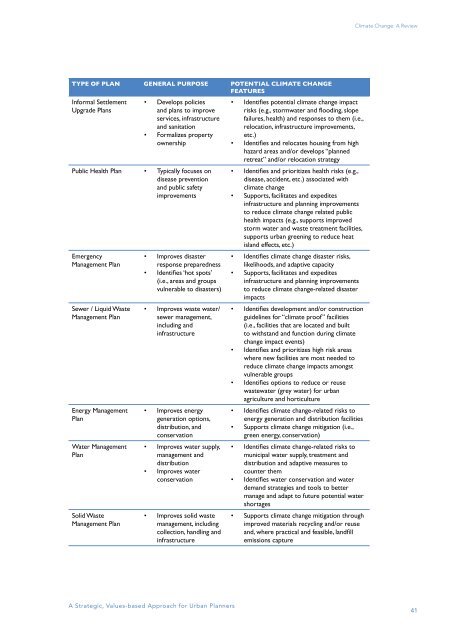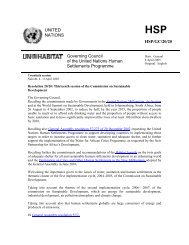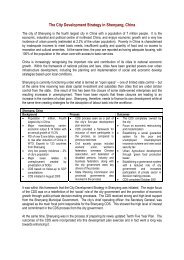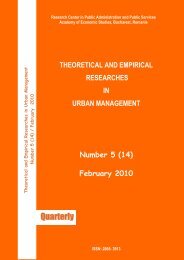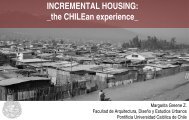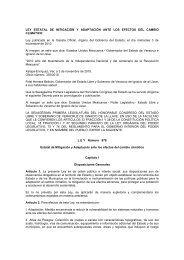Planning for Climate Change - UN-Habitat
Planning for Climate Change - UN-Habitat
Planning for Climate Change - UN-Habitat
Create successful ePaper yourself
Turn your PDF publications into a flip-book with our unique Google optimized e-Paper software.
<strong>Climate</strong> <strong>Change</strong>: A Review<br />
TYPE OF PLAN GENERAL PURPOSE POTENTIAL CLIMATE CHANGE<br />
FEATURES<br />
In<strong>for</strong>mal Settlement<br />
Upgrade Plans<br />
<br />
<br />
Develops policies<br />
and plans to improve<br />
services, infrastructure<br />
and sanitation<br />
Formalizes property<br />
ownership<br />
Public Health Plan Typically focuses on<br />
disease prevention<br />
and public safety<br />
improvements<br />
Emergency<br />
Management Plan<br />
Sewer / Liquid Waste<br />
Management Plan<br />
Energy Management<br />
Plan<br />
Water Management<br />
Plan<br />
Solid Waste<br />
Management Plan<br />
<br />
<br />
<br />
<br />
<br />
<br />
<br />
Improves disaster<br />
response preparedness<br />
<br />
(i.e., areas and groups<br />
vulnerable to disasters)<br />
Improves waste water/<br />
sewer management,<br />
including and<br />
infrastructure<br />
Improves energy<br />
generation options,<br />
distribution, and<br />
conservation<br />
Improves water supply,<br />
management and<br />
distribution<br />
Improves water<br />
conservation<br />
Improves solid waste<br />
management, including<br />
collection, handling and<br />
infrastructure<br />
<br />
<br />
<br />
<br />
<br />
<br />
<br />
<br />
<br />
<br />
<br />
<br />
<br />
<br />
<br />
<br />
failures, health) and responses to them (i.e.,<br />
relocation, infrastructure improvements,<br />
etc.)<br />
<br />
hazard areas and/or develops “planned<br />
retreat” and/or relocation strategy<br />
<br />
disease, accident, etc.) associated with<br />
climate change<br />
Supports, facilitates and expedites<br />
infrastructure and planning improvements<br />
to reduce climate change related public<br />
health impacts (e.g., supports improved<br />
storm water and waste treatment facilities,<br />
supports urban greening to reduce heat<br />
island effects, etc.)<br />
<br />
likelihoods, and adaptive capacity<br />
Supports, facilitates and expedites<br />
infrastructure and planning improvements<br />
to reduce climate change-related disaster<br />
impacts<br />
<br />
guidelines <strong>for</strong> “climate proof” facilities<br />
(i.e., facilities that are located and built<br />
to withstand and function during climate<br />
change impact events)<br />
<br />
where new facilities are most needed to<br />
reduce climate change impacts amongst<br />
vulnerable groups<br />
<br />
wastewater (grey water) <strong>for</strong> urban<br />
agriculture and horticulture<br />
<br />
energy generation and distribution facilities<br />
Supports climate change mitigation (i.e.,<br />
green energy, conservation)<br />
<br />
municipal water supply, treatment and<br />
distribution and adaptive measures to<br />
counter them<br />
<br />
demand strategies and tools to better<br />
manage and adapt to future potential water<br />
shortages<br />
Supports climate change mitigation through<br />
improved materials recycling and/or reuse<br />
<br />
emissions capture<br />
A Strategic, Values-based Approach <strong>for</strong> Urban Planners<br />
41


